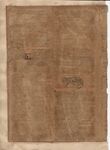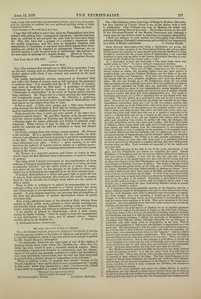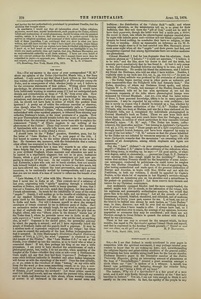< Colonel H. S. Olcott on Recent Criticisms–Psychical Drawings (continued from page 7-88) >
I have seen in your possession a portrait in black and white of an Indian religious ascetic, which is entirely unique. It would require an artist of very extraordinary power to reach the degree of ability which is expressed in this work. There is a oneness of treatment difficult to attain, with a pronounced individuality, combined with great breadth. As a whole, it is an individual. It has the appearance of having been done on the moment, a result always inseparable from great art. I cannot discover with what material it is laid on the paper. I first thought it chalk, then pencil, then Indian ink; but a minute inspection leaves me quite unable to decide. Certainly, it is neither of the above.
If, as you tell me, it was done instantaneously by Madame Blavatsky, then all I can say is, she must possess artistic powers not to be accounted for on any hypothesis except that of magic. The tint seems not to be laid on the surface of the common writing paper upon which the portrait is made, but to be combined, as it were, with the fibres themselves.
No human being, however much genius he might have, could produce the work, except with much time and painstaking labour; and, if my observation goes for anything, no medium has ever produced anything worthy of being mentioned beside it.
Studio Building, 31, West 10th Street, New York.
I hope this will suffice to show that when we Theosophists have been charged with putting forth “unsupported assertions,” injustice has been done us, and that we are not quite the rash fools we have been taken for. Men who have had a quarter of a century’s experience with the medial phenomena, and who have no sympathy whatever with materialists, or Christians, or any other class which opposes their investigation, are neither to be regarded as incompetent observers, nor as banded together to split the great body of Spiritualists into factions for the mere sake of carrying out a sinister design.
New York, March 12th, 1878

<Untitled> (The following letter from...)
Sir,-—The following letter from Capt. O’Grady to Madame Blavatsky has been handed by Colonel Olcott to me, at her desire, with a view to publication. Capt. O’Grady was born at Madras, his father and grandfather having been in the army. His brother is now on the staff of the Governor-General of the Madras Presidency, and although a young man, he has written much in American newspapers about India. I shall not indicate to your readers how thoroughly Capt. O’Grady endorses Madame Blavatsky’s statements, and certifies to her competency as a critic of Hindoo esotericism.
Dear Madame Blavatsky,—Not being a Spiritualist, nor having the happiness of being a member of the Theosophical Society, and private affairs having caused my seclusion for some months past from any likelihood of being brought in contact with the present phases of Spiritualism, I was somewhat surprised to learn that my letter to the London Spiritualist, showing up some remarks by Mr. Peebles, had created quite a “stir.”
As I understand it, there has been quite a fuss made lately about four special points in “Isis.” To these I will give categorical attention.
1. As to the Todas, my personal acquaintance with them was limited. I one day saw five or six. They were of light complexion, not fair or ruddy, having indeed no colour, but decidedly lighter than any other natives of southern India, even than the Namburi Brahmins, and the Nairs of the best families in Cochin and Travancore. They were very handsome, well-made, but dressed with the most primitive simplicity, and I must say, didn’t look clean. My wife was brought up on the Neilgherries, where she was taken when an infant, and she probably knew more about the traditions and general native opinion regarding the Todas than any masculine investigator. Of course the natives are more or less communicative among themselves, and ladies who are kind to their servants, and are in one way or another brought so much in contact with them, find them communicative, too. The ayahs, or tirewomen and nurses, are as full of legendary lore as any Scotch crone that ever lived. My wife picked up a good deal of this, and so did I, at secondhand. Now, so far as I could make out, the Todas are regarded by the tribes immediately surrounding them, and even by the low-country natives, who, since the opening up of the Neilgherries some forty years ago, have moved up there in the train of the Europeans, as a very superior people; and it is said of them, and believed, that they never cut their hair, never carry any weapon but a long staff, which they only use as a symbol of authority, or by way of a walking-stick, and not as a weapon at all; never work at any sort of labour, and as lords of the soil are supplied with clothes, food (except milk), and everything they require, by another hill tribe, the Badagas, who are quite industrious, and in some cases even wealthy. The Todas have herds of buffaloes, which supply them with milk, and it is said, protect themselves from tigers, and their masters from the consequences of over-population. There is probably no sort, of authority for the assertion, or Government would have taken steps to prevent the barbarity; but the natives say that all but a certain percentage of female infants, and all deformed children, are trampled to death by the buffaloes. The Todas, it is said, practise polyandry—it is certain few women are ever seen with them—and, it is popularly believed, are never molested by wild beasts or reptiles, although they move with perfect freedom about the hills. Their numbers are supposed to be but small—not more than 400.
2. The tiger-shooting on the hills is one of the great enjoyments of the place, and the Neilgherries are famous for supplying fine sport. Colonel Hamilton, of Ootacamund, and his two sons are famous shilcatris (or hunters), and have scores of trophies. I went out one day—the only time I got- a chance—after one of the largest tigers ever shot, with the two young men and the Hon. John Napier, of the 92nd Highlanders, and aide-de-camp to his father, Lord Napier (of Ettrick), Governor of Madras. The sholas, or thickly-wooded ravines between the grassy knolls of the hills, are a favourite lurking-place for tigers. Panthers have been killed actually in gardens at Conoor. As to serpents, I have heard there were none on the hills, and take it for granted they are there, as everywhere else in India. If there were none, there would certainly have been as much said about it as about the freedom of Ireland from snakes—by the grace of St, Patrick. Personally, I don’t think I saw more than ten live snakes (except, of course, with the jugglers) all the years I was in India, yet, I understand, the most trustworthy statistics charge an annual death rate of 30,000 to snakes.
3. A Goparam is the great pyramidal gateway of the Pagodas, but—by a figure, common enough in all languages—the part is often taken for the whole, and the word Goparam used, both in literature and conversation, to signify the whole temple. And very naturally, I should say, for the gate of the Temple, or, at best, its outer courts, as it is narrated of the Israelites, are all that the masses have anything to do with. They never penetrate to the inner precincts. Any hair-splitting about this word really seems to me excessively childish, and scarcely in good faith.
4. As I believe the great masses of Hindoos are in as absolute ignorance about their own cults as the lazzaroni of Naples, or the wild Irish of Galway, or the back slums of New York, or the Liberties of Dublin, about the theology of Catholicism, and that it is with the lower castes alone Europeans ever have any sort of intimate relations, I believe the mysteries of Brahminism to be something very difficult, indeed, well-nigh impossible "for any European to penetrate, even after many years of investigation on the spot. With all courtesy and gentleness of demeanour, the Brahmin is impenetrable as to his inner self. The Europeans, too, with the pride of race natural to conquerors, do, even the best of them (with few exceptions), and while not admitting the fact to their own consciences, look down on the “niggers.” And the natives feel this with an almost miraculous sensitiveness. That there are friendships between Europeans and high caste natives I do not deny. There are, and of the most noble character. But, in the exchange of good offices, of esteem and ready helpfulness in every way, the sort of friendship where men’s hearts and souls are thrown open to each other, does not exist between the antagonistic races. They may share purses, but they don’t show their love-letters.
Tho Hindoos certainly guard their faith too closely for any casual observer to find out anything about it. It is the one thing which they will fight for against any odds. They may put up with extortion, torture, the vilest fruits of tyranny, if their religion is let alone. The East India Company, to the disgust of Exeter Hall, subsidised the Pagodas, and would not allow missionaries to land, and the present Government, to the disgust of the missionaries, whom, however, it allows to land, continues the subsidies, but contributes nothing to the missionaries.
It was with great difficulty that suttee and sitting Dhurna (a ereditor deliberately starving himself to death before a debtor’s door, and so bringing his blood on his soul) were abolished as customs (though cases still sporadically occur), and it was only by proving that the Shastras had been misinterpreted, and having the fact authoritatively proclaimed by prominent Pundits, that the abolition was brought about.
In conclusion I would say that all information about Indian religions, mysteries, sacred men, mystic brotherhoods, such people as the Todas, esoteric beliefs and explanations of occult phenomena, should be taken with the greatest caution, unless it is known that the narrator is in perfect accord with the natives on religious questions, and possessed of their entire confidence. As to both of these requisites, I am convinced that you show in what you have written, and still more forcibly by what I have heard you relate, where things that I personally know and can explain have been dovetailed with things which I knew of, or had heard of, and were previously not intelligible to me, but which you made perfectly clear and logical, that you, Madame Blavatsky, are an unquestionable authority on all these matters. I have not even heard of any one—except perhaps the Abb4 Dubois, who I suspect knew more than he committed to paper—to approach you. Believe me, with the greatest esteem and respect, yours most truly,
176, Broadway, New York, March 27th, 1878.

The Todas
Sir,—For my answer to the sneer of your correspondent “H. M.” about my opinion of the Todas (Spiritualist, March 8th), a few lines sufficed. I only cared to say that what I have written in Isis Unveiled was written after reading Colonel Marshall’s A Phrenologist among the Todas, and in consequence of what, whether justly or not, I believe to be the erroneous statements of that author. Writing about Oriental psychology, its phenomena and practitioners, as I did, I would have been ludicrously wanting in common sense if I had not anticipated such denials and contradictions as those of “H. M.” from every side. How would it profit the seeker after this occult knowledge to face danger, privations, and obstacles of every kind to gain it, if, after attaining his end, he should not have facts to relate of which the profane were ignorant? A pretty set of critics the ordinary traveller or observer, even though what Dr. Carpenter euphemistically calls a “scientific officer,” or “distinguished civilian,” when, confessedly, every European unfurnished with some mystical passport, is debarred from entering any orthodox Brahman’s house, or the inner precincts of a pagoda. How we poor Theosophists should tremble before the scorn of those modern Daniels when the cleverest of them has never been able to explain the commonest “tricks” of Hindu jugglers, to say nothing of the phenomena of the Fakirs! These very answer the testimony of Spiritualists with an equally lofty scorn, and resent as a personal affront the invitation to even attend a seance.
I should have let the “Todas” question, therefore, pass, but for the letter of “Late Madras C. S.,” in your paper of the 15th. I feel bound to answer it, for the writer plainly makes me out to be a liar. He threatens me, moreover, with the thunderbolts that a certain other officer has concealed in his library closet.
It is quite remarkable how a man who resorts to an alias sometimes forgets that he is a gentleman. Perhaps such, is the custom in your civilised England, where manners and education are said to be carried to a superlative elegance; but not so in poor, barbarous Russia, which a good portion of your countrymen are just now preparing to strangle (if they can). In my country of Tartaric Cossacks and Kalmucks, a man who sets out to insult another, does not usually hide himself behind a shield. I am sorry to have to say this much, but you have allowed me, without the least provocation, and upon several occasions, to be unstintedly reviled by correspondents, and I am sure that you are too much of a man of honour to refuse me the benefit of an answer.
<... continues on page 7-89 >
Editor's notes
Sources
-
London Spiritualist, No. 294, April 12, 1878, pp. 177-8
-
London Spiritualist, No. 294, April 12, 1878, p. 178


